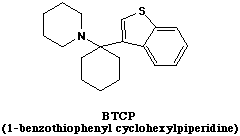
Numerous derivatives of PCP have been synthesized which contain additional rings systems or restrict the conformational flexibility of the phenyl, cyclohexyl, and/or piperidine rings by adding bonds between them. Additionally, there are at least six structural classes of compounds that can produce PCP-like effects in animals. There are several reasons for continuing research on these compounds. First, they have unique pharmacological actions that may be developed into as yet unknown clinical agents. Besides the potential for further anesthetic agents, there is the possibility for neuroprotective agents, because of their ability to reduce tissue damage during oxygen deprivation and other trauma such as siezure. Also, if PCP does indeed induce a mental state that is biologically related to schizophrenia, then compounds that antagonize its action may be useful in the treatment of this disease. Finally, compounds that selectively bind to the PCP receptor are necessary for research in order to better define its physiological role.
Most of the effects of PCP result from its binding to noncompetative NMDA receptors. PCP also binds at a number of other receptors with lesser affinity, and many derivatives have been synthesized with much more selectivity for these other receptors. There are several research areas on those analogs that have recieved particular interest.
1) Areas for research: dopamine receptors:
One facinating example of modification to PCP's structure results in a class of compounds with entirely different and novel actions. This is the replacement of the phenyl ring with a benzothiophene ring to give the derivative BTCP, illustrated below.

These compounds show little affinity for the PCP receptor, but some are very potent at blocking dopamine reuptake. Some of these compounds, such as 1-[1-(2 benzo[b]thienyl)cyclohexyl]pyrrolidine, the analog of BTCP in which the piperidine ring has been replaced with pyrrolidine, bind to the cocaine receptor site with potency greater than cocaine itself. Members of this family also bind to a second site on the dopamine transporter receptor that is distinct from cocaine's binding site. This discovery has raised hopes of medicinal chemists that a derivative of BTCP may be developed that would anagonize the actions of cocaine and be of use in cocaine addiction (ref. 27, 28, 40, 41, 39). Conversely, the discovery of BTCP's ability to bind to cocaine receptors has also raised hopes among clandestine chemists for a potent, easy to synthesize cocaine-like compound.
As of yet, there has not been a formal evaluation of BTCP derivatives in man, but testing in animals has revealed the possibilty that some of these compounds may be effective stimulants similar to cocaine. In one unstructured and informal assay of BTCP's effects in man by vaporization and inhalation, no subjective effects were apparent. However, there is the possibility that the dosage employed was not high enough to produce discernable effects (ref. 14). Additionally, the pyrrolidine analog of BTCP would be a more logical choice for evaluation in man as it has a higher affinity at cocaine's binding site.
Synthesis of these compounds is achieved readily through the enamine route for PCP (reaction scheme II), by substituting 2-lithio benzothiophene for phenyl lithium. The 2-lithio benzothiophene reagent can be prepared by reacting benzothiophene (also known as thianaphene) with butyl lithium. Method I for PCP, using the nitrile intermediate is also effective (ref. 39).
2. Areas for research: sigma receptors:
Another class of binding sites discovered during research on PCP derivatives are the sigma receptors. Initially the sigma receptor was thought to be the site by which PCP produced its psychoactivity. However,recent studies indicate that although PCP binds to the sigma receptor its pharmacology is more due to interaction at a noncompetative NMDA binding site (the "PCP receptor"). Many compounds that bind to the PCP receptor also bind at sigma sites. Interestingly, some compounds that produce similar bizarre alterations in consciousness as PCP and have rather low affinity at PCP receptors, such as the benzomorphans (figure 2), have a higher affinity for sigma sites. such compounds is seen. Another example is dextromethorphan (DXM), which of is known to cause unusual dissociative mental states at higher doses.
The best known compound with appreciable affinity for the sigma receptor is the benzomorphan Pentazocine (Talwin, figure 2). This drug is a mixed agonist/antagonist at opiate receptors and generally has lower abuse potential in opiate (ab)users than pure agonists such as morphine. However, this drug is more desired than other opiates by certain users. When it is injected intravenously, especially in combination with an antihistamine (so-called "T's and Blues"), it may produce a euphoric rush that is said to be unique and overwhelmingly pleasurable. It also may produce a dissociative state with similarities to PCP. All in all, there is not enough evidence to say with any certainty what the sigma receptor's physiological function is, but the possibility that it may be playing a role in dissociative states remains an interesting area for future research.
4. Areas for research: opiate receptors:
A number of PCP analogs have been found to have an analgesic action. This action is due in a number of cases to their affinity at opiate receptors, and the compounds generally show a reduced affinity for PCP receptors. One example is the analogs with a hydroxy group on the 4-position of the phenyl ring, one of which is twice as potent as morphine (ref 49).